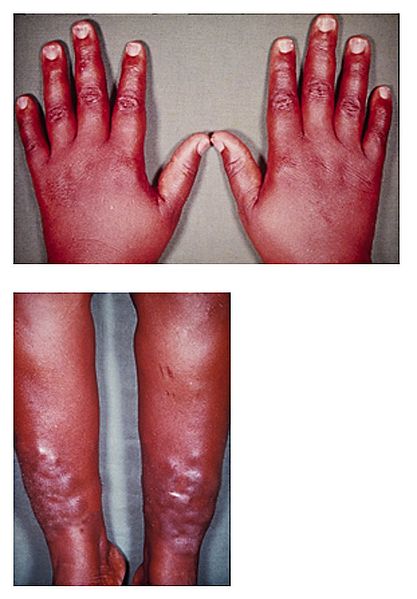Graves' disease natural history, complications and prognosis
|
Graves' disease Microchapters |
|
Diagnosis |
|---|
|
Treatment |
|
Medical Therapy |
|
Case Studies |
|
Graves' disease natural history, complications and prognosis On the Web |
|
American Roentgen Ray Society Images of Graves' disease natural history, complications and prognosis |
|
FDA on Graves' disease natural history, complications and prognosis |
|
CDC on Graves' disease natural history, complications and prognosis |
|
Graves' disease natural history, complications and prognosis in the news |
|
Blogs on Graves' disease natural history, complications and prognosis |
|
Risk calculators and risk factors for Graves' disease natural history, complications and prognosis |
Editor-In-Chief: C. Michael Gibson, M.S., M.D. [1];Associate Editor(s)-in-Chief: Seyedmahdi Pahlavani, M.D. [2]
Overview
Cardiac complications are the most important complications of Graves' disease because they are life threatening. Heart failure and atrial fibrillation are the most common cardiac complications. Thyroid dermopathy which presents as pretibial myxedema and acropachy, is another complication. Thyroid associated ophthalmopathy must be evaluated in every patient with Graves' disease. Thyroid crisis is another life threatening complication of Graves' disease.
Natural History, Complications and Prognosis
Natural History
- If left untreated, it may lead to serious complications such as thyroid storm, life threatening arrhythmias, orbitopathies, weight loss and even osteoporosis.
- The clinical features of Graves' disease generally worsen without treatment, the mortality from Graves' disease was 10–30% before the introduction of satisfactory therapy. Some patients with mild Graves’ disease experience spontaneous relapses and remissions.
Complications
Cardiac complications
- Older patients are more vulnerable to develop cardiovascular complications compared to younger patients.[1]
- When compared with people older than 60 years with a healthy thyroid, those who are hyperthyroid have three times the risk of atrial fibrillation.[2]
- Embolic stroke related to atrial fibrillation secondary to hyperthyroidism is significantly more prevalent than embolic stroke related to atrial fibrillation from non-thyroidal causes.[3]
- AF is considered as an independent risk factor for CHF in patients with Graves' disease.[4]
Cardiac manifestations of Graves' disease include palpitations, anginal chest pain, exercise intolerance, atrial fibrillation, exertional dyspnea, cardiac hypertrophy, systolic hypertension, peripheral edema, hyperdynamic precordium, pulmonary hypertension and heart failure.[5]
Thyrotoxic periodic paralysis
- There is a shift of potassium into the muscle cells.[6]
- It is characterized by the triad of muscle paralysis, acute hypokalemia and thyrotoxicosis.
Thyroid-Associated Ophthalmopathy
- The clinical course of ophthalmopathy does not follow that of the thyroid disease. Ophthalmopathy typically worsens over the initial 3–6 months, followed by a plateau phase over the next 12–18 months, with spontaneous improvement.[1]
- The earliest manifestations of ophthalmopathy are usually a sensation of grittiness, eye discomfort, and excess tearing.
- Approximately one third of patients have proptosis. Proptosis can be measured using an exophthalmometer.
- In severe cases, proptosis may cause corneal exposure and damage, especially if the lids fail to close during sleep.
- Periorbital edema, scleral injection, and chemosis are also frequent.
- In 5–10% of patients, the muscle swelling is so severe that diplopia results.
- The most serious manifestation is compression of the optic nerve at the apex of the orbit, leading to papilledema, peripheral field defects, and permanent loss of vision if left untreated.[1]
Thyroid dermopathy
- It occurs in <5% of patients with Graves’ disease.
- The typical lesion is a noninflamed, indurated plaque with a deep pink or purple color and an orange skin appearance.
- Nodular involvement can occur and the condition can rarely extend over the whole lower leg and foot, mimicking elephantiasis.
- Thyroid acropachy refers to a form of clubbing found in <1% of patients with Graves’ disease.[7]
Thyroid storm
- Thyroid crisis is a life threatening exacerbation of hyperthyroidism, manifested by fever, delirium, seizures, coma, vomiting, diarrhea, and jaundice. The mortality rate due to cardiac failure, arrhythmia, or hyperthermia is as high as 30%, even with treatment.
- Thyrotoxic crisis is usually precipitated by acute illness (e.g., stroke, infection, trauma, diabetic ketoacidosis), surgery (especially on the thyroid), or radioiodine treatment of a patient with partially treated or untreated hyperthyroidism.
Prognosis
The overall prognosis with treatment is good.
References
- ↑ 1.0 1.1 1.2 Devereaux D, Tewelde SZ (2014). "Hyperthyroidism and thyrotoxicosis". Emerg. Med. Clin. North Am. 32 (2): 277–92. doi:10.1016/j.emc.2013.12.001. PMID 24766932.
- ↑ Sawin CT, Geller A, Wolf PA, Belanger AJ, Baker E, Bacharach P, Wilson PW, Benjamin EJ, D'Agostino RB (1994). "Low serum thyrotropin concentrations as a risk factor for atrial fibrillation in older persons". N. Engl. J. Med. 331 (19): 1249–52. doi:10.1056/NEJM199411103311901. PMID 7935681.
- ↑ Chen Q, Yan Y, Zhang L, Cheng K, Liu Y, Zhu W (2014). "Effect of hyperthyroidism on the hypercoagulable state and thromboembolic events in patients with atrial fibrillation". Cardiology. 127 (3): 176–82. doi:10.1159/000356954. PMID 24434544.
- ↑ Siu CW, Yeung CY, Lau CP, Kung AW, Tse HF (2007). "Incidence, clinical characteristics and outcome of congestive heart failure as the initial presentation in patients with primary hyperthyroidism". Heart. 93 (4): 483–7. doi:10.1136/hrt.2006.100628. PMC 1861478. PMID 17005710.
- ↑ Jabbar A, Pingitore A, Pearce SH, Zaman A, Iervasi G, Razvi S (2017). "Thyroid hormones and cardiovascular disease". Nat Rev Cardiol. 14 (1): 39–55. doi:10.1038/nrcardio.2016.174. PMID 27811932.
- ↑ Vijayakumar A, Ashwath G, Thimmappa D (2014). "Thyrotoxic periodic paralysis: clinical challenges". J Thyroid Res. 2014: 649502. doi:10.1155/2014/649502. PMC 3945080. PMID 24695373.
- ↑ Smith TJ, Hegedüs L (2016). "Graves' Disease". N. Engl. J. Med. 375 (16): 1552–1565. doi:10.1056/NEJMra1510030. PMID 27797318.
